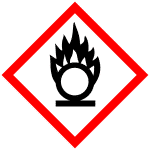| Pack Size | Availability | Purity | Price | User Price | Quantity |
|---|---|---|---|---|---|
| 10g | 1-3days | 95% | |||
| 20g | 1-3days | 95% |
| Transport Condition | |
|---|---|
| Storage Temp. | −20°C |
| Hazard Codes |   |
| Storage Condition | |
| Feature | |
| Biological Activity | |
| Character | 固体 |
| Chemical Stability | |
| Hazardous Decomposition Products | |
| Useage | |
| Dangerous Goods | |
| Flash Point | |
| Safety Statements | S26;S36; |
| Physicochemical Propertie | |
| Vapor Pressure |
| Signal Word | Warning |
|---|---|
| InchiKey | NKLCNNUWBJBICK-UHFFFAOYSA-N |
| Canonical Smiles | CC(=O)OI1(OC(=O)C2C=CC=CC1=2)(OC(C)=O)OC(C)=O |
| Inchi | InChI=1S/C13H13IO8/c1-8(15)19-14(20-9(2)16,21-10(3)17)12-7-5-4-6-11(12)13(18)22-14/h4-7H,1-3H3 |
| Density | |
| Smiles | CC(OI1(OC(C)=O)(C2=C(C=CC=C2)C(=O)O1)OC(C)=O)=O |
| MDL No. | MFCD00130127 |
| Remark | |
| Water Solubility | |
| Exact Mass | 423.96551 |
| Chirality | |
| GHS | 火焰在圆环上叹号 |
| HS Code | |
| Cas No. | 64297-64-9 |
| Chemical Name | Dess-Martin periodinane |
| Synonyms | |
| Standard English name | Triacetoxyperiodinane; Dess-Martin periodinane |
| UN No. | 1479 |
Properties:
Des Martin oxidizer is chemically a complex compound. It is a strongly oxidizing compound that is highly reactive.
Uses:
Des-Martin oxidizer is widely used in organic synthesis to oxidize alcohols, dilute alcohols, alcohol ethers, unsaturated compounds and aromatic compounds to ketones, aldehydes and acids.
Method of Preparation:
Dess-Martin oxidizer can be prepared in several ways. One common method of preparation is to mix chromium trioxide (CrO3) with acetic acid and dilute it with sulfur dioxide (SO2) and then react it with aromatic ketones to obtain Des Martin's oxidizer.
Safety Information:
It is irritating and corrosive, avoid contact with skin and eyes. In use, appropriate protective equipment such as eyeglasses, gloves, and extra-laboratory suction devices should be worn. In addition, Dess-Martin Oxidizer should be kept away from combustible and flammable materials and stored properly in sealed containers to avoid contact with other chemicals. When disposed of, it needs to be disposed of in accordance with relevant regulations.
Sorry, there is currently no relevant literature available
Sorry, there is currently no browsing history